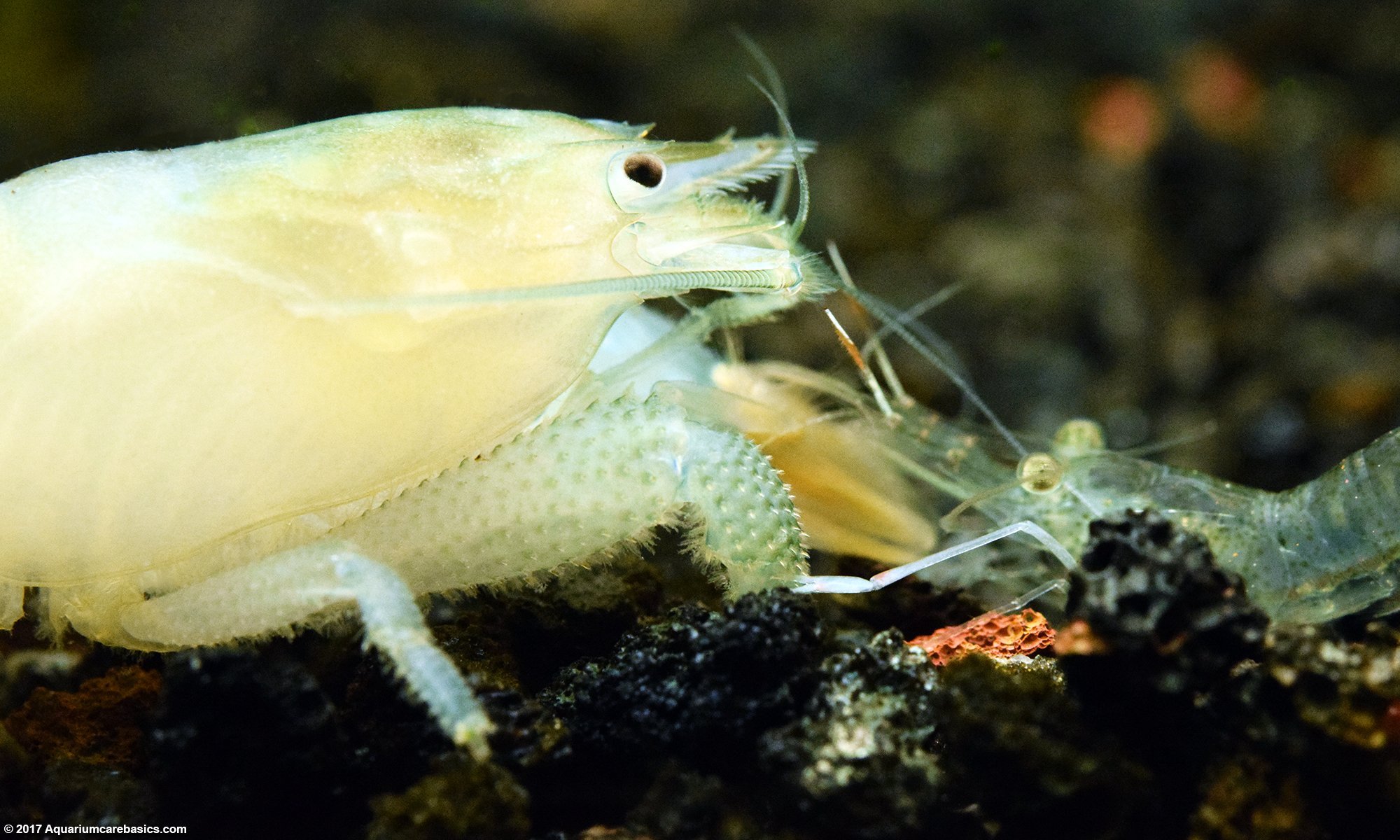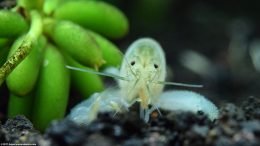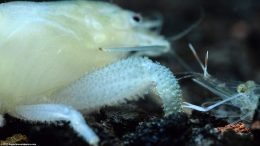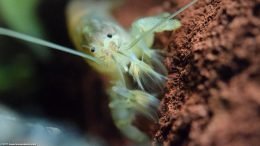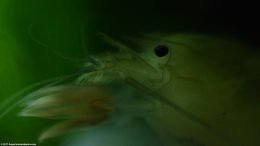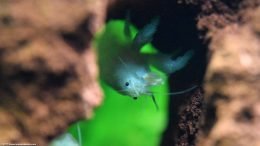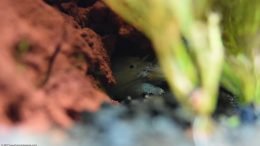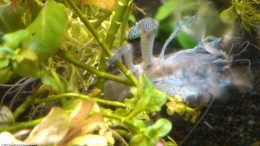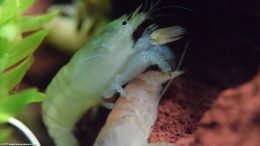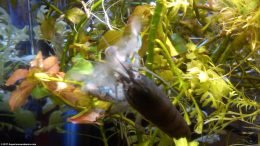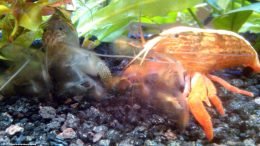Vampire Shrimp, Atya gabonensis, also known as African Fan Shrimp, Giant African Fan Shrimp, African Filter Shrimp, Giant African Filter Shrimp, Gabon Shrimp, or Viper Shrimp, are natives of parts of Western Africa and parts of South America. Vampire Shrimp are fan feeders that snatch their food from the water current in the tank with their little fanned hands. They are peaceful, tranquil, on the shy side and they like little places to hide. At the same time, Vampire Shrimp seems to be very social with other filter shrimp. They appear to be very comfortable hanging out in the water current with other freshwater shrimp, especially Bamboo Shrimp.
Vampire Shrimp Care: Considerations
Vampire Shrimp care is generally the same as with other types of aquarium shrimp. Avoid copper as it is fatal. Keep Ammonia, Nitrite and Nitrate levels in check. Keep water parameters stable, and be careful with medications. Vampire Shrimp care should be easy provided good fish keeping habits are present: regular partial water changes, frequent water testing, avoiding over feeding, avoiding overstocking, and the like.
Vampire Shrimp Gallery
Shrimp Tank Size
Vampire Shrimp need a decent amount of water volume to feed, so the bigger the tank, the better. A 20 gallon aquarium can be a good tank size to start with. Of the 20 gallon tanks, a 20 gallon long tank can be a good choice because the dimensions are 30 x 12 x 12. A 30 inch length means there is a decent amount of aquarium bottom to walk on. The 12 inch height means it isn’t very hard to keep the water current moving quickly throughout the tank.
Environment & Water Parameters
Vampire Shrimp are filter feeders so there should be plenty of food floating in the water column to keep them well fed. Keeping a tank well planted is a good idea because live aquarium plants shed little bits of edible matter into the tank water. Live plants also give shrimp places to explore, climb on and hide in. Aquariums with live plants are traditionally a little messier than tanks with plastic plants. Live aquarium plants prevent the tank from becoming “too clean”. Tanks that are “too clean” may not have enough natural edible matter floating around for these shrimp to eat.
Vampire Shrimp seem happy with established and stable aquarium water parameters in the tropical fish tank range:
Water Temperature: 74 – 84 Degrees Fahrenheit
Water pH: 7.0 – 7.5, although some sources suggest a pH as low as 6.5 is ok.
Ammonia: 00 ppm
Nitrite: 00 ppm
Nitrate: 20 ppm
They also seem to be healthy with aquarium water that is on the hard side, with a constantly moving oxygen rich current. There also should be a couple of places to hide: under rocks and decorations, under thick plants, or around a sponge filter.
Vampire Shrimp: Diet, Food & Feeding
Vampire Shrimp food consists mainly of edible plant matter in the water, bits of otherwise uneaten fish food, and probably tiny edible microorganisms floating in the tank that are too small to be seen. In addition to this, it’s also a good idea to supplement their diet with food made up of finely ground fish pellets, shrimp pellets, finely ground algae wafers, or small flakes. These can be ground into a fine powder and added to the current upstream of the Vampire Shrimp. A pinch or two at the time will cause the food particles hit the shrimp square in its filter fans. After a few tries, it’s easy to get the hang of it.
Vampire Shrimp Size, Color & Lifespan
Vampire Shrimp size is generally about two to three inches in length, although some claim that lengths up to six inches is possible. Another observation about Vampire Shrimp size is that they are “thicker” looking that other aquarium shrimp. Compared to the thinner and more streamlined Bamboo Shrimp, Vampire Shrimp look more “heavy-duty” shell-wise. Maybe it is the actual thickness of their torso and tail, or maybe its the thickness of their legs, but Vampire Shrimp have a boxy size and appearance.
Another interesting observation is that they have little bumpy points on their sides of their legs, and one larger point on the end of their legs. Perhaps these points are necessary to help wild Vampire Shrimp hold on to wood, rocks or sticks as they face strong currents. In any event, the heavy duty look and points on their legs give Vampire Shrimp a menacing appearance. But nothing can be further from the truth. These shrimp are one of the most docile and harmless inhabitants in a tank.
Vampire Shrimp also have long slender antennae on the top of their heads. Perhaps these feelers come in handy when they move around at night.
Color Range & Lifespan
Vampire Shrimp color ranges between a light blue-ish grey and darker shades of blue-ish grey. Sometimes their color can shift to have a cream color, a pink color, or even a hint of green added in. Other possible colors can include a rusty maroon or brown, and even straight blue. It’s really very interesting to see all of the different colors that occur.
Vampire Shrimp lifespan varies, but some can live a pretty long time. I have had some that lived for three years and I’ve heard stories where some have been pushing five years. If a tank is stable and healthy and the shrimp is well fed and cared for, he (or she) should last a pretty long time. That said, its not uncommon for Vampire Shrimp to die shortly after being added to a tank. Perhaps it’s due to the differences in the home tank water compared to the display tank water. Or it could also be due to the stress of being transported, or just the condition of the shrimp itself. Either way, the possibility is worth a mention.
Vampire Shrimp Molting Process
Vampire Shrimp molting seems to occur once every couple of months. It will grow a new shell under his present one. When molting occurs, the shrimp will crack out of its old shell leaving it behind. During the molting process, a Vampire Shrimp probably feels very vulnerable. So it will look for a quiet and safe place to hide. A common molting hiding spot is behind a power filer water intake. So make sure there are a couple of spots like this for your African Filter Shrimp to find when molting time comes.
After a Vampire Shrimp sheds its old shell it will appear empty, either stuck in some plants or on the bottom of the tank. Many hobbyists new to shrimp keeping may think that the shrimp has died. This is not the case. In a day or so, or even in a matter of a a couple of hours, the African Fan Shrimp will appear again looking sharp in its new shell.
With some molted shells, it’s a good idea to leave the empty shell in the tank for a day or so, because other shrimp seem to like to eat the discarded shell. This is especially true with Amano Shrimp shells which are soft and easily eaten. Shrimp often re-ingest the minerals in the discarded shells to help them get ready for their next molt. Viper Shrimp shells are tougher, however. Other shrimp do not seem to be as interested in re-ingesting the minerals from these shells. Perhaps the discarded Viper Shrimp shells are too hard and tough to eat. In any event, leaving the shell in for a while is worth a try. If the other shrimp do not start picking at the empty shell, it can be taken out of the tank after molting.
Vampire Shrimp Tank Mates
Vampire Shrimp tank mates can include others of their kind as well as other freshwater aquarium shrimp the likes of Bamboo Shrimp, Amano Shrimp, Red Cherry Shrimp, and Ghost Shrimp. Tank mates can also include freshwater snails like Malaysian Trumpet Snails, Ramshorn Snails, Mystery Snails, Gold Inca Snails, Ivory Snails and Nerite Snails. Some non-aggressive community tank fish can work as well. Care must be taken to not mix Vampire Shrimp aquarium crayfish and other roughens like cichlids or Goldfish, as the Vampire Shrimp may end up being a tasty appetizer. If there is any doubt as to compatibility, its best to get the opinion of the store clerk before purchasing.

